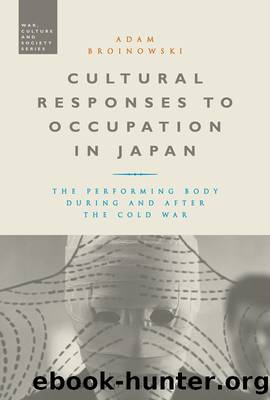Cultural Responses to Occupation in Japan by Broinowski Adam

Author:Broinowski, Adam.
Language: eng
Format: epub
Publisher: Bloomsbury UK
Otaku and Article 9: The beginning of the security shift
As the otaku debate was taking place in the 2000s, following the launch of the War on Terror in 2003, a parallel realpolitik debate intensified over Article 9 of the 1947 ‘peace Constitution’, which at least restricted Japan to strictly self-defence of the homeland from invasion and military attack and from settling international disputes through military force. With a climbing PRC military budget and its increased territorial assertiveness, claims of Japan’s emasculated and masochistic ‘passivity’ intensified. Political voices grew louder for Japan to revise Article 9 so as to become a ‘normal’ nation.
Some view the post-1945 US–Japan relationship as Hobbesian: the citizen (Japan) trades its liberty (autonomous foreign policy) for the protection of the ‘Leviathan’ (the United States). A strict Schmittian reading – ‘the Sovereign is he who decides on the exception’ and exercise the right to kill an enemy – would frame the United States as the sovereign of Japan. As the post-1945 US hegemon is itself un-fettered by Article 9, it is entrusted to fill the vacuum of a vacated or incapacitated sovereign to protect this territory on Japan’s behalf (Williams in Stockwin et al. 2006: 51–55), making it a proxy sovereign.
In this situation, it is often argued that the US victor took away Japan’s military capability and Japan voluntarily assumed a posture of ‘self-restraint’ and subordination to the US hegemon. Suggestive of negative liberty (Berlin 1969), in this reading, Japan’s actions are inhibited by its own Constitution instead by an external force. This condition is sometimes blamed on the theoretical application of negative sovereignty and subjecthood by the post-war and contemporary Japanese intellectual left, who used Foucault’s notion of the ‘subjectless subject’ to define Japanese post-war identity (Takahashi 2005). In this view, in their rejection of an ‘innate’ Japanese (mostly masculine and martial) predisposition towards violent death (or ‘suicide culture’), a ‘sadomasochistic’ configuration has been established, wherein the US master (‘Sword’) ‘cares’ for slave Japan (‘Chrysanthemum’) and assumes responsibility for their defence. It is crucial in this argument that Japan be seen as voluntarily embracing this role.
Just as in the mediated Otaku Japan narrative, this master–slave dialectic frames a ‘post-Japan’ of neutered ‘Japanese’ that is emptied of the right and will to defend and therefore define itself as a sovereign nation. The repeated accusation in US commentary that Japan shirks responsibility to defend its sovereign right to belligerency (i.e. ‘gets a free ride’) projects a Lacanian self-‘severance’, creating a phantom emptiness where an authentic self once resided. Provoking a desire for suture, those who subscribe to this view seek to re-instate a recognizable (phallic) form of sovereignty so that Japan may exercise its ‘normal’ right on the world stage once more.
From the ‘might is right’ position of strategic realism, grounded in a fundamental misreading of Darwinian ‘survival of the fittest’, the capacity for military belligerence is key to a perceived natural human will to survive and a requirement in the aim to accumulate power, territory and resources. In
Download
This site does not store any files on its server. We only index and link to content provided by other sites. Please contact the content providers to delete copyright contents if any and email us, we'll remove relevant links or contents immediately.
| Africa | Americas |
| Arctic & Antarctica | Asia |
| Australia & Oceania | Europe |
| Middle East | Russia |
| United States | World |
| Ancient Civilizations | Military |
| Historical Study & Educational Resources |
The Tale of Genji (unabridged) by Shikibu Murasaki(1003)
Japan by Edwin Reischauer(908)
The Complete Guide to Japanese Drinks by Stephen Lyman & Chris Bunting(883)
Shogun by James Clavell(834)
The Pacific War by Robert O'Neill(764)
Native American in the Land of the Shogun: Ranald MacDonald and the Opening of Japan by Frederik L. Schodt(763)
Japanese Notebooks by Igort(759)
Shogun (The Asian Saga Chronology) by James Clavell(718)
Japanese Candlestick Charting by Steve Nison(714)
Last Mission to Tokyo by Michel Paradis(710)
Bushido Explained by Alexander Bennett(690)
The Dutch Encounter with Tokugawa Japan by Adam Clulow(686)
The Pillow Book by Sei Shonagon(681)
The Great Road by Smedley Agnes;(678)
Ninja Fighting Techniques by Stephen K. Hayes(667)
Last Mission to Tokyo: The Extraordinary Story of the Doolittle Raiders and Their Final Fight for Justice by Michel Paradis(628)
Underground: The Tokyo Gas Attack and the Japanese Psyche by Haruki Murakami(623)
People Who Eat Darkness by Richard Lloyd Parry(613)
Comfort Woman by Maria Rosa Henson(605)
